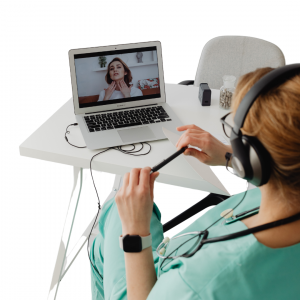People living with diabetes are at greater risk of developing eye problems. Diabetes damages blood vessels all over the body. Damage to your eyes starts when sugar blocks the tiny blood vessels that go to your retina, causing them to leak fluid or bleed. Your eyes then grow new blood vessels that don’t work well. It is called diabetic retinopathy and causes vision loss in people who have diabetes. Diabetic retinopathy usually affects both eyes.
Symptoms
You might not have symptoms in the early stages of diabetic retinopathy. As the condition progresses, symptoms may include:
- Spots or dark strings floating in your vision (floaters)
- Blurred vision
- Fluctuating vision
- Impaired colour vision
- Dark or empty areas in your vision
- Vision loss
Careful management of diabetes is the best way to prevent vision loss. If you have diabetes, see your eye doctor for a yearly eye exam with dilation — even if your vision seems good. Contact your doctor right away if your vision changes suddenly or becomes blurry, spotty, or hazy.
Diabetes is a complex disease that can be treated. The disease requires continuous management to ensure quality of life and to prevent serious complications that may be life threatening. Know the facts.
What happens at a diabetic eye screening?
The doctor will start with an eye check and then administer drops that will dilate your pupils. This will allow him to have a detailed view of the inside of the eyes. The doctor will also photograph the interior of your eyes.
The drops may sting, and the bright lights of the photographs can be startling. Your eyes will be blurry for about 15 minutes, and you will not be able to focus on objects close to you. It can last for up to six hours, so you won’t be able to drive home after your appointment. You may also find that everything seems brighter than usual; consider wearing sunglasses after the screening.
During the eye examination, the doctor can detect the presence of:
– Abnormalities in the blood vessels, optic nerve, or retina
– Cataracts
– Changes in eye pressure or overall vision
– New blood vessels
– Retinal detachment
– Scar tissue
Other eye screenings are:
- Fluorescein angiography where a special dye called fluorescein gets injected into a vein in the patient’s arm. Photos are taken as the dye circulates through the eyes. This test can determine which blood vessels are blocked, leaking fluid, or are damaged.
- Optical coherence tomography (OCT) is a non-invasive imaging scan providing high-resolution cross-sectional images of the retina, revealing its thickness. OCT is like ultrasound testing but uses light rather than sound to produce images. The scan can also detect diseases of the optic nerve.
Looking after your eyes
There are a few things you can do alongside your eye screening to keep track of your eye health:
– Look out for any changes to your sight e.g. floaters, dimmer vision, struggling to see in the dark
– Know your target blood sugar levels
– Manage your blood pressure and cholesterol levels
– Eat a healthy diet and be active
– Give up smoking












